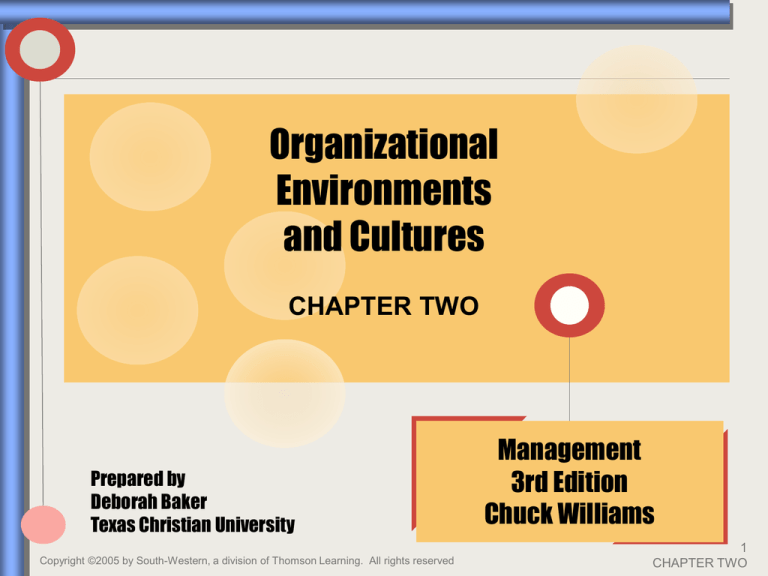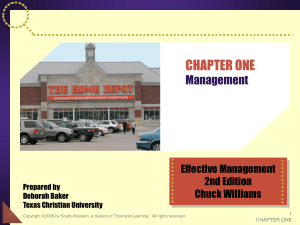
Organizational
Environments
and Cultures
CHAPTER TWO
Prepared by
Deborah Baker
Texas Christian University
Copyright ©2005 by South-Western, a division of Thomson Learning. All rights reserved
Management
3rd Edition
Chuck Williams
1
CHAPTER TWO
What Would You Do?
You are the CEO of McDonald’s…
Sales are declining,
stores are closing
Competitors are stronger
Food quality is dropping,
food preferences have
changed
Service is rude and inaccurate
How can you deal with these
external and internal problems
and turn them into opportunities?
Copyright ©2005 by South-Western, a division of Thomson Learning. All rights reserved
2
CHAPTER TWO
External Environments
After reading the next four
sections, you should be able to:
1.
discuss how changing environments affect
organizations.
2.
describe the four components of the general
environment.
3.
explain the five components of the specific
environment.
4.
describe the process that companies use to make
sense of their changing environments.
Copyright ©2005 by South-Western, a division of Thomson Learning. All rights reserved
3
CHAPTER TWO
Changing Environments
Characteristics of
Changing External Environments
Environmental Change
Environmental Complexity
Resource Scarcity
Uncertainty
1
Copyright ©2005 by South-Western, a division of Thomson Learning. All rights reserved
4
CHAPTER TWO
Environmental Change
Environmental Change is the rate at which a
company’s environments change
stable environments
dynamic environments
Punctuated equilibrium theory
companies cycle through stable and dynamic
environments
1.1
Copyright ©2005 by South-Western, a division of Thomson Learning. All rights reserved
5
CHAPTER TWO
Punctuated Equilibrium: U.S. Airlines
3rd Revolutionary Period: Following
September 11th terrorist attack.
U.S. Airline Industry
$15,000,000
Operating
$10,000,000
1st Revolutionary
Period:
Deregulation of U.S.
Airline Industry
$5,000,000
2001
2000
1999
1998
1997
1996
1995
1994
1993
1992
1991
1990
1989
1988
1987
1986
1985
1984
1983
1982
1981
1980
1979
1978
1977
$0
1976
$ in Thousands
Equilibrium: Followed by
another period of industry
stability.
2nd
Revolutionary
Period: Rising
Cost of Jet Fuel
and Employee
Salaries and
Benefits
Equilibrium: Followed by a
period of industry stability.
-$5,000,000
Operating
-$10,000,000
-$15,000,000
1.1
Year
Copyright ©2005 by South-Western, a division of Thomson Learning. All rights reserved
6
CHAPTER TWO
Environmental Complexity
Environmental Complexity: the number of external
factors in the environment that affect organizations
Simple environments
have few environmental factors
Complex environments
have many environmental factors
1.2
Copyright ©2005 by South-Western, a division of Thomson Learning. All rights reserved
7
CHAPTER TWO
Resource Scarcity
Resource scarcity is the degree to which
an organization’s external environment
has an abundance or scarcity of critical
organizational resources
1.3
Copyright ©2005 by South-Western, a division of Thomson Learning. All rights reserved
8
CHAPTER TWO
Uncertainty
Uncertainty is how well managers can understand
or predict the external changes and trends
affecting their businesses
Environmental
Uncertainty
Exhibit 2.2 Environmental Uncertainty
Environmental Complexity, Environmental Change, & Resource Scarcity
High
Medium
Low
Environmental Complexity
Environmental Change
Resource Scarcity
Environmental Characteristics
1.4
Copyright ©2005 by South-Western, a division of Thomson Learning. All rights reserved
9
CHAPTER TWO
General Environment
Organization
Specific Environment
General Environment
2
Copyright ©2005 by South-Western, a division of Thomson Learning. All rights reserved
10
CHAPTER TWO
Components of the General Environment
Economy
Technological
Sociocultural
Political / Legal
2
Copyright ©2005 by South-Western, a division of Thomson Learning. All rights reserved
11
CHAPTER TWO
Economy
Growing vs. shrinking economies
Future economic activity is difficult to predict
Business confidence indices
show how confident managers are about future
business growth
2.1
Copyright ©2005 by South-Western, a division of Thomson Learning. All rights reserved
12
CHAPTER TWO
Technological Component
Technology--
Input
Knowledge
Tools
Techniques
Output
Raw
Materials
Products
Information
Services
2.2
Copyright ©2005 by South-Western, a division of Thomson Learning. All rights reserved
13
CHAPTER TWO
Sociocultural Component
Sociocultural Components
Demographic changes
Changes in behavior, attitudes, and beliefs
2.3
Copyright ©2005 by South-Western, a division of Thomson Learning. All rights reserved
14
CHAPTER TWO
Demographics Example
90.0%
80.0%
% of Married Women with Children Who Work
Children Under 6
77.2%
Children 6 to 17
73.6%
70.0%
62.0%
60.0%
49.2%
50.0%
40.0%
62.8%
58.9%
45.1%
39.0%
30.3%
30.0%
20.0%
18.6%
10.0%
0.0%
1960
1970
1980
1990
2000
2.3
Copyright ©2005 by South-Western, a division of Thomson Learning. All rights reserved
15
CHAPTER TWO
Political / Legal Component
Legislation
Regulations
Court decisions
Managers must be
educated about the laws,
regulations, and potential
lawsuits that could affect
business
http://www.eeoc.gov/laws/cra91.html
2.3
Copyright ©2005 by South-Western, a division of Thomson Learning. All rights reserved
16
CHAPTER TWO
Specific Environment
Customer
Competitor
Supplier
Industry regulation
Advocacy group
3
Copyright ©2005 by South-Western, a division of Thomson Learning. All rights reserved
17
CHAPTER TWO
Customer Component
Monitoring customer
wants and needs
is critical for
business success
Reactive customer monitoring
responding to problems, trends, and events
Proactive customer monitoring
anticipating problems, trends, and events
3.1
Copyright ©2005 by South-Western, a division of Thomson Learning. All rights reserved
18
CHAPTER TWO
Competitor Component
Competitive Analysis
Deciding who your competitors are
Anticipating competitors’ moves
Determining competitors’
strengths and weaknesses
3.2
Copyright ©2005 by South-Western, a division of Thomson Learning. All rights reserved
19
CHAPTER TWO
Competitive Analysis
The Ten Commandments for
Ethical Decision Making
http://www.scip.org
http://www.scip.org/library/8(3)eea.pdf
Thou Shalt …
•
•
•
•
•
•
•
•
•
•
3.2
Not lie when representing yourself
Observe the company’s legal guidelines
Not tape-record a conversation
Not bribe
Not plant eavesdropping devices
Not deliberately mislead anyone in an interview
Not obtain nor give price information to a competitor
Not swap misinformation
Not steal a trade secret
Not press someone for information if it may jeopardize that
person’s job or reputation
Adapted from Fuld & Company
Copyright ©2005 by South-Western, a division of Thomson Learning. All rights reserved
20
CHAPTER TWO
Supplier Component
Buyer
Dependence
Suppliers
Opportunistic Behavior
Supplier
Dependence
Relationship Behavior
3.3
Copyright ©2005 by South-Western, a division of Thomson Learning. All rights reserved
21
CHAPTER TWO
Industry Regulation Component
Consists of regulations and rules that govern the
business practices and procedures of specific
industries, businesses, and professions
3.4
Copyright ©2005 by South-Western, a division of Thomson Learning. All rights reserved
22
CHAPTER TWO
Federal Regulation Agencies
Consumer Product
Safety Commission
http://www.cpsc.gov
Environmental Protection Agency
http://www.epa.gov
Equal Employment
Opportunity Commission
Federal Communications
Commission
3.4
http://www.eeoc.gov
http://www.fcc.gov
Federal Reserve System
http://www.federalreserve.gov
Federal Trade Commission
http://www.ftc.gov
Food and Drug Administration
http://www.fda.gov
National Labor Relations Board
http://www. nlrb.gov
Occupational Safety and
Health Administration
Securities and Exchange
Commission
Copyright ©2005 by South-Western, a division of Thomson Learning. All rights reserved
http://www.osha.gov
http://www.sec.gov
23
CHAPTER TWO
Advocacy Groups
Groups of concerned citizens who band together to
try to influence the business practices of specific
industries, businesses, and professions
Techniques to try to influence companies
public communications
media advocacy
product boycotts
3.5
Copyright ©2005 by South-Western, a division of Thomson Learning. All rights reserved
24
CHAPTER TWO
Making Sense of Changing Environments
Environmental
Scanning
Evaluating
External
Environments
Interpreting
Environmental Factors
Acting on
Threats and Opportunities
4
Copyright ©2005 by South-Western, a division of Thomson Learning. All rights reserved
25
CHAPTER TWO
Environmental Scanning
Environmental scanning: searching the
environment for events or issues that might affect
an organization
Scanning the environment:
keeps companies current on industry factors
reduces uncertainty
alters organizational strategies
contributes to organizational performance
4.1
Copyright ©2005 by South-Western, a division of Thomson Learning. All rights reserved
26
CHAPTER TWO
Interpreting Environmental Factors
Managers determine what environmental events and
issues mean to the organization
Opportunities
Threats
4.2
Copyright ©2005 by South-Western, a division of Thomson Learning. All rights reserved
27
CHAPTER TWO
Acting on Threats and Opportunities
Managers have to decide how to respond to these
environmental factors
Cognitive maps
simplified models of external environments
depicts how managers believe environmental
factors relate to possible organizational actions
4.3
Copyright ©2005 by South-Western, a division of Thomson Learning. All rights reserved
28
CHAPTER TWO
Cognitive Maps
4.3
Copyright ©2005 by South-Western, a division of Thomson Learning. All rights reserved
29
CHAPTER TWO
Internal Environments
After reading this section,
you should be able to:
5.
explain how organizational cultures are created and
how they can help companies be successful.
Copyright ©2005 by South-Western, a division of Thomson Learning. All rights reserved
30
CHAPTER TWO
Internal Environments
Internal environment consists of the
trends and events within an organization
that affect the management, employees,
and organizational culture
important because it affects what people
think, feel, and do at work
organizational culture is the set of key
values, beliefs, and attitudes shared by
organizational members
Copyright ©2005 by South-Western, a division of Thomson Learning. All rights reserved
31
CHAPTER TWO
Creation and Maintenance of
Organizational Cultures
Company Founder
Organizational Stories
Organizational Heroes
5.1
Copyright ©2005 by South-Western, a division of Thomson Learning. All rights reserved
32
CHAPTER TWO
Successful Organizational Cultures
Adaptability
Consistency
Involvement
Clear Vision
Sales
Growth
Return on
Assets
5.2
Employee
Satisfaction
Profits
Quality
Adapted from Exhibit 2.7
D.R. Denison & A.K. Mishra, Organization Science 6(1995): 204-223
33
Copyright ©2005 by South-Western, a division of Thomson Learning. All rights reserved
CHAPTER TWO
Blast from the Past
Corporate history helps employees and
managers understand the people, and events,
and changes that shaped a company
Preserves culture and values
Gets people involved in the culture of a
company
5.2
Copyright ©2005 by South-Western, a division of Thomson Learning. All rights reserved
34
CHAPTER TWO
Levels of Organizational Culture
Symbolic artifacts 1. Surface
Behaviors
Level
SEEN
What people say
How decisions
are made
2. Expressed Values
and Beliefs
Beliefs and
assumptions
Rarely discussed
3. Unconsciously
Held Assumptions
and Beliefs
5.3
Copyright ©2005 by South-Western, a division of Thomson Learning. All rights reserved
HEARD
BELIEVED
Adapted from Exhibit 2.8
35
CHAPTER TWO
Been There Done That
The beliefs and values of Starbucks Coffee
success has to be shared
people are the most
significant component
a culture of meaning and loyalty
grassroots decision making
Copyright ©2005 by South-Western, a division of Thomson Learning. All rights reserved
36
CHAPTER TWO
Changing Organizational Cultures
Behavioral addition
is the process of having managers and
employees perform a new behavior
Behavioral substitution
is having managers and employees perform a
new behavior in place of another behavior
Change visible artifacts
such as the office design and layout, company
dress codes, etc.
5.3
Copyright ©2005 by South-Western, a division of Thomson Learning. All rights reserved
37
CHAPTER TWO







